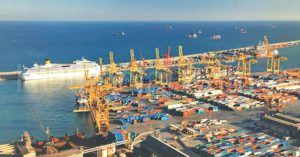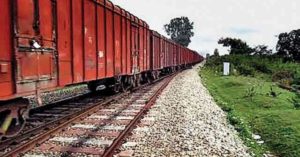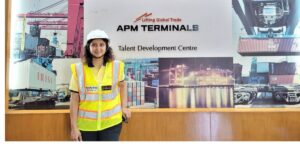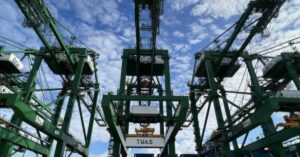Bhatia Shipping was established in 1964 as Customs House Agents and since then the business has evolved into a large integrated logistics service provider. Bhatia shipping provides an entire gamut of services, viz. international freight forwarding, multimodal transportation, customs brokerage, transportation, etc.
So, let me begin with the hot question now. When everyone thought that okay, we have passed the Corona pandemic and business began as usual, the second wave started hitting us badly. So, I want to know firsthand from you what is the ground situation because you are one of the largest custom house agents. See, we have seen exports growing and cargo moving swiftly once the corona wave started slowing down but again, I see the offices are now operated with limited people and then I think ports are also hit to some extent and especially, Maharashtra is under severe wave. So, how is the scenario? Because at one place if it is alright then the rest of the area is under lockdown or shutdown, so what is the disruption that you are feeling right now?
So, it’s actually the flavour of the season, this question. I will just share a few thoughts on this. We are in a very fortunate position. Our industry was one of the first industries to enter into digitization and I mean to say, primarily from the government side, custom side which drove the trade also to reciprocate in similar fashion for upgradation. So, we had custom started EDI back in the 90s, computerization of the processes. Since then to now, we have travelled 30 years and the benefit of that initial drive is now being enjoyed by the industry that the amount of disruption in our trade is very limited compared to other industries and this again, we are very fortunate that our industry, the processes are in two parts: one is the actual physical movement; they cannot be replicated by anything else but a major part about movement is the documentation whether it be with the customs, whether it be with the shipping lines. So, due to the early initiatives taken by the government, we are now enjoying the fruits that we have been very easily been able to conduct our business in comparison to other industries and we have come into normalcy much faster than the other industries and the effects are seen in the trade statistics that trade has actually grown but with very miniscule impact or difficulties faced by the people to do it. Primarily, the only difficulties which our trade members are facing would probably be how do you commute in times of lockdown when public transport is not available and difficulties smaller organizations or larger organizations if your manpower is found positive, it internally disrupts your whole working processes but as far as enabling provisions go to conduct the business, the environment has supported us tremendously. So, our industry has been, I would say, fortunate to have the least impact on coming back to normalcy.
That’s good to know. In any operations, we have these 3 elements: service providers, customers and invariably government departments play a role. Here it is customs. So, in terms of digitalization using digital technology for all our operations, to what extent all the 3 areas have been properly plugged in and then functioning?
I would say, as far as digitization goes, you would be 90% plus in terms of documentation. There is very miniscule movement where there are certain aspects of the trade processes which could not be digitized as far as customs go and as far as shipping lines go, the physical document, the title of goods, the original bill of lading, there we have not done much progress on blockchain or digital documents and there is a good amount of movement of physical documents, so I would say it’s 90% plus. In fact, the trade also very quickly moved to pre-releases instead of releasing original bills of lading and sending it to destination, the trade started releasing an OBLs and sending it to the clients, the banks would negotiate the documents and there would be a Telex release. They have improvised the processes, they have worked around it so that the physical movement also gets reduced.
So, in your experience, now you say that the industry is reaping the benefits of using digital technologies for our operations. Apart from documentation, what else is happening in the industry in terms of using technology and what do you see in the near future, what advantages or what changes would come in this area?
It’s very difficult to predict because we are now as it is 90%, I would say plus digitized, the last mile 10% probably will never get 100% digitized for various reasons – comfort factor, etc, etc., but more so future, your business is going to be working on digital platforms and physical sending emails or physically exchanging documents, that is going to get more and more reduced, even this 10% may get reduced to probably to 2% or 5%, so the future is digital, it is no going back on that.
Are customers comfortable with using these digital platforms?
Yes, in fact, customers probably find it easier to map their processes when they are working in a digital environment rather than working on emails or other manual document processes. So, the shift is towards digitization.
You are also actively involved with lot of policy-related issues, making recommendations and you were associated with several trade organizations. So, on policy front, what is happening currently in our industry, shipping and logistics?
The flavour of the season now, going forward would be the national logistics policy and your national logistics portal and the government has also realized its necessity to get higher efficiency, be able to digest or deliver the growth prospects which we all see as a writing on the wall that the volume is going to grow, for various reasons. This too would need to be moved on faster and both these things will probably come into play in the current year and we should reap the benefits of this in times to come.
You are also associated with FILA and one of the architects of FILA, so what is happening with FILA now?
FILA is a different story. The whole purpose and the objective of FILA – we have 3 primary goals to be achieved. The first goal which we had worked upon, as a commonality of interest for all the trade associations was a cargo community system, second was skill development, and the third was branding of logistics industry as a profession of choice because this particular objective cannot be achieved by individual associations but it’s a very generic requirement of the trade. If you ask any logistics professional, he has probably got into the business of logistics either because he has inherited the business from his parents or he had some friend working in the industry and he was looking for avenues so he came into the logistics industry and a good amount, they didn’t get any other jobs, so they said, why not logistics? So, we all collectively felt that FILA should be formed for these three basic purposes, which individually associations would be able to achieve. Unfortunately, for the cargo community system, FILA for various reasons did not take the mantle on themselves to do it. There are certain countries out of India where the trade has taken over the role of maintaining the cargo community system and association with the government but some of the FILA members felt that there should not be any financial commitment made by FILA so we lost that opportunity though government was very interested to give it to us as the trade. Skill development, we had got a one-acre property with 20,000 square feet given to us at one rupee rent by SIPCO and JNPT. There also certain constituents felt that if we were to do skill development, the government will probably say that all the people who have been skilled by you, now you need to employ them and there would be a form of commitment made by FILA for employment. So, they felt that we should not venture into taking that property and establishing a skill development centre. The third is something which cannot be quantified very easily but it is the spirit which we need to achieve by multiple things which we need to do but when the first two things themselves could not be achieved by FILA independently, the third was very difficult to achieve so AMTOI was the primary promoter of FILA but when these first two goals were not taken by FILA, we felt to do advocacy with the government on generic issues, each association has different goals as different objectives. So, to come on a platform and make FILA an advocacy group for the community would probably lead to cross-purposes and would not really achieve the goals in totality for individual associations and the common goals which could have been achieved were not being taken up by FILA. So unfortunately, we withdrew from FILA though FILA continues. Their other constituents are continuing but with few of the associations like AMTOI, we decided that we would do advocacy on our own rather than have FILA to do advocacy on our behalf. So, FILA started with a very good objective but unfortunately, we could not carry forward what we had joined together to do so AMTOI has withdrawn from it.
Now customs came up with lot of regulatory changes for the positive developments in its operations, how to treat all the custom house agents and we were also, for last few years discussing how the custom broking has to become more professional with a lot of value-added services and all that. So, from the both sides, both on the regulatory side within your own custom house broking community, so what changes have come and what do you see?
So, the major changes in the last year has been the faceless assessment initiative and drive of customs. Initially, there were lot of hiccups, there was resistance from all quarters, from the custom officers side as well as from the CHAs side because both were very habituated to meet each other and explain their documents to each other or, you know the classification or any dispute which arose or a difference of opinion which arose, people were very comfortable meeting in person and getting it sorted out but the government clamped down and said nothing doing, faceless assessment should go on. So, I see now the future is going to be faceless assessment though it was actually a proposal made by BCHA which is now BCBA, I would say around 15 years back and the purpose of faceless assessment as per our proposal was back then different. Back then, the problem which the trade was facing was that a single commodity was being assessed at different values and sometimes under different classifications by different customs. So, there was a tendency of importers to do shopping of which custom house they should route their goods through which made the actual genuine players at a back foot because the genuine players were at a disadvantage if they correctly classified it or they correctly valued it whereas another custom house the similar commodity was taken for the benefit of a notification reducing the rate of duty as well as probably paying less duty because of again valuation aspects. We as BCHA had suggested to the government that they should specialize custom houses for certain commodities and all India, a single commodity should be assessed at a single custom house so that there is a uniformity of its assessment in terms of valuation, in terms of its classification. It’s when there are different custom houses, genuinely also there can be differences of opinions and more so because as you know in customs, every 6 months or 1 year, the dealing officer changes by routine transfers. So, obviously, they are unable to achieve that level of specialization and in the initial stages, they could be either misguided or have a difference of opinion. So, the actual objective for faceless assessment when it was proposed by BCHA 15 years back was to achieve a uniformity of assessment but the whole thing changed and it became different though it is good, there is nothing wrong with it but I still see that the specialization is not taking place and there is still that goal which needs to be achieved by the government. On the trade side, the future for a single service shop gets a little bit limited because the tendency of trade is one-stop shop. They want to go to someone who will cater to their complete requirement at one-stop, so whether it be forwarding, custom clearance, transportation, warehousing, the tendency of the trade is that the more the people they deal with, there is a cost to them also for dealing with that. So, they would rather have one contract which should deal with the total end-to-end solution for the client. So, going forward I feel, there will be need for trade, either make one-stop shops which are again is not as easy to do as you see it, because there are limitations, you cannot be good at everything and you would become jack of all and master of none and the trade today is based on specialization and very price sensitive. So, until you don’t have scales of volume or tremendous expertise, you cannot conduct and do your business as efficiently as is required by the trade. So, the next question comes up, how do you address this because ultimately small players also need to survive. So, I see people need to collaborate, they need to make alliances, they need to get together and that is only the way forward. Nobody would die, no business will stop but the way the business will be conducted in future needs to be changed because this change is derived not by the supplier of the service but it is demanded by the user of the service and customer is always king. So, if he wants something, he needs to get it. So, the trade will probably evolve now, there will be alliances, there will be people getting together, that’s the only way people will do it. These are my few thoughts on this.
Let’s talk about your company, Bhatia Shipping. Now I understand that it is close to about 55 years old almost, a little more than half century and what started as a small family business of custom house agents, now evolved into an integrated logistics solutions company. Can you give me an insight into the how the journey was and what are the plans now?
I will share a personal story which very few people in the trade know. We are in this business, starting from my father, by an accident. It was not a profession of choice for my father also. So, my grandfather, we had a joint family business. We were guarantee brokers for PNB Pribas and Union Bank of India. So, in pre-independence and post-independence, banks didn’t lend people money directly. They had guarantee brokers in between who would guarantee the loan and only a guarantee broker who is recognized by the bank, the banks had their recognized guarantee brokers, they would be authorized to recommend loans. So, there was a dispute in our family and my grandfather was the eldest brother and his younger brother said that you know if you want to continue with the business, you have to throw all your children out of the business but then only the business will continue and my grandfather being the eldest, he didn’t want to be instrumental in breaking up the business so he told all his children, there were five brothers, that you are to find your own avenues and took things outside. Incidentally for my father, my grandfather got him employed in an oil cake manufacturing unit in Indore. So, my father was removed from the family business, he went to Indore, he served in this company, it was owned by my grandfather’s friend and he started handling his eggs. After a few months, the owner said, look why are you here, you go and become a clearing agent in Bombay and you handle my total exports in Bombay. So, from there, my father came to Bombay and he started doing clearing. That time, we didn’t even have our license. He used somebody’s license and he started and then fortunately for me, I inherited it from him so I had a readymade platform and then as is evolution, it’s always easy to grow a plant which is already, you know the seeds are there and the plant has sprouted, now you want to make it bigger, it’s easier than to actually sow the seed and create the plant and make it big. So, I am thankful to my father that I got the opportunity to inherit this business and its where it stands but all the credit goes to him. He had a very good market reputation, we used to do total cycle parts of Ludhiana, we did hand tools of Jalandhar spare parts of Jalandhar and diesel engine parts and we had a market share in the 80s more than 50% volume of trade in these products. So, I was very fortunate. Though, today we have zero business of all these four industries and we changed and we have more clients which are in Maharashtra and Gujarat and zero in that Northern part that’s the background and talking about the future, the way I see it, the need of the hour is to collaborate, is even at my level whatever enterprise value we have, the future to stand alone would be very difficult and we will have to align with players, like-minded players and try to get together a package of services which we would be able to extend to our clients without actually necessarily having to do that business yourself because it is difficult to create critical mass and become a professional or leader in every segment of the trade you operate. So, the way I see it, the future is only getting together which I would also tell my brothers in the trade…whether it is the CHA industry or forwarding industry, that’s the future. You will need to get together.












